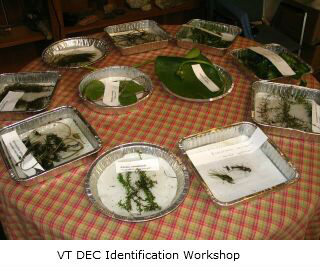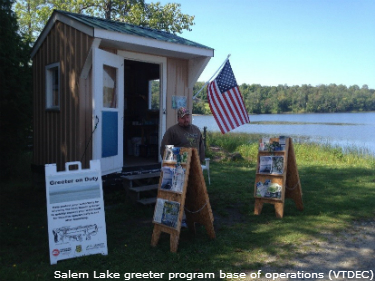Aquatic Nuisance Control Grant-In-Aid Program
The Aquatic Nuisance Control (ANC) Grant-in-Aid Program provides financial assistance to municipalities and agencies of the state for aquatic invasive and nuisance species management programs. Funding for the ANC Grant-in-Aid grants comes from a portion of annual revenues from motorboat registration fees and federal funds. This grant program has supported over 70 municipalities since 1994.
Who May Apply?
The applicant must be a municipality or a Regional Partner. Local interest groups such as lake associations must apply through the municipality in which the waterbody is located. If the waterbody is located in more than one municipality, affected municipalities may but are not required to apply jointly.
 What Types of Projects are Eligible?
What Types of Projects are Eligible?
ANC Grant in Aid awards are made to priority projects to the extent funds are available. First priority is to projects designed to manage new infestations of aquatic nuisances or to establish novel programs. Second priority is to projects to prevent or control the further spread of aquatic nuisance species. Third priority is to recurring maintenance projects.
The following criteria are also considered: public accessibility and recreational uses; importance to commercial, agricultural or other interests; the degree of local interest; local efforts to control aquatic nuisances; other considerations affecting feasibility, probability of achieving long-term control, and necessity or advantage of the proposed work; and the extent to which the control project is a developmental rather than a maintenance program.
Additional criteria considered in approving requests and determining the amount of any grant include: the use of the waters by persons outside the municipality in which the waters are located; the long-range effect of the control project; the recreational use of the waters; and the effectiveness of municipal shoreland zoning and other controls in minimizing or preventing existing or new development from having any adverse effects on the waters subject to the control program.

2025 ANC Grant-in-Aid Application Materials
The Aquatic Nuisance Control Grant-in-Aid Program provides financial assistance to municipalities and agencies of the State for aquatic nuisance species as required by the Aquatic Nuisance Control Vermont Statutes (10 V.S.A. § 1458). The full RFP is available at Aquatic Nuisance Control Grant in Aid 2025 Request for Proposals on the Vermont Business Registry.
Applications must be submitted in electronic format (preferably pdf), clearly labeled and emailed to VTDEC Grants Management Specialist, Renee Pszyk at anr.decgms@vermont.gov. The deadline for submission is 4:00 p.m. EST on March 21 and was extended to April 14, 2025. Applicants will receive a confirmation email that the application was received within 48 hours of submission. If confirmation is not received, the application was not received and therefore will be considered invalid. Award notifications will go out no later than April 18, 2025.
For technical information or questions regarding the application please contact Kimberly Jensen, VTDEC Lakes & Ponds Aquatic Nuisance Control Grant in Aid Technical Project Manager, at kimberly.jensen@vermont.gov or (802) 490-6120.
Please see the 2025_ANC_Grant-in-Aid_Application_Manual.pdf for guidance on filling out the application.
An Aquatic Nuisance Control Grant-in-Aid Program Bidder's Conference was held on Wednesday, March 11, 2025. Meeting Minutes are available here, ANC2025_Bidders_Conference_Minutes.pdf.
Submit proposal in electronic format preferably using the pdf fillable forms listed below in one merged document for each project titled: (Using the Chrome browser may reduce computer glitches.)
Town – Waterbody ANC24 GP Proposal; Example: Morristown–Lamoille ANC24 GP (Greeter Program, etc.) Proposal
- 2025_ANC_GIA_I._Application_Cover_Page.pdf - only one cover sheet should be submitted per application
- 2025_ANC_GIA_II.A._Greeter_Project_Sheet.pdf - submit one Greeter Project Sheet for each individual greeter project proposed
- 2025_ANC_GIA_II.B._Education,Outreach,Survey_Project_Sheet.pdf- submit one Education, Outreach, or Survey Project Sheet for each EOS project proposed
- 2025_ANC_GIA_II.C._ Management_Project_Sheet.pdf - submit one Management Project Sheet for each control/plant management project proposed
- 2025_ANC_GIA_III._Project_Budget.pdf - submit one Project Budget Form for each project proposed
- VTDEC Temporary Equipment Use Request Approval Form - submit with application (if applicable)
- Act_154_ANR_Good_Standing_Certification.pdf - submit one per applicant (Municipality or Regional Partner)
- DEC_ Risk_Assessment_Questionnaire.pdf - submit one per applicant (Municipality or Regional Partner)
- Certificate of Insurance (Municipality or Regional Partner)
- ANR Online Grants & Contracts Vendor Guidance Document - guidance for submitting deliverables and invoices
- Link to Vermont Watershed Basin Map
Funding Information
VTDEC may provide awards for 75% or less of the total estimated project cost as outlined in the Aquatic Nuisance Control Program Vermont State Statutes. However, due to the great number of requests, ANC awards usually provide funds at a much lower proportion of the total estimated project cost listed in the proposals. Final payments will be issued in the same proportion to final project expenditures, up to the maximum award amount. Awardees are expected to complete the scope of work as described in the application and funding is provided based on the full completion of the work. Participants must contribute the required cost share % through direct cash expenditures or valid documented non-cash volunteer services, and/or donated services, equipment, or supplies for the project as described in the application. Only expenditures accrued within the awarded project timeline is considered eligible cost share.
Participating Cost Reporting Information
Participants will be required to provide information for the receipt of the funded award that includes: a description of how the project was successfully completed; the persons, contacts, or sub-contractors involved in the projects; the actions taken to meet the deliverables; the anticipated timeline to which the project was implemented; and clear and accurate maps of the project location (if applicable). A copy of the news or social media announcement during or after the project took place will be required as part of the grant deliverables. Depending on the project, participants may be obligated to fulfill additional requirements (e.g., attend a Department offered public access greeter training, submit electronic data to Department staff).
The final grant payment will be based on accurate records for the final Total Project Cost. Supporting documentation will be required to be submitted including a Final Project Report Form and Final Project Expenditures Report Form. In addition to grant-funded expenditures, awardees are responsible for maintaining financial records, time sheets or logged hours for all non-cash/volunteer, donated services or supplies, that will be listed.
The Final Award Payment = Maximum Award Amount X (Actual Project Costs / Proposed Project Costs)
For more information, contact Kimberly Jensen
Vermont Watershed Grants
Watershed grants are available to projects focused on protecting and restoring watersheds. These grant funds are available for water-related projects that focus on fish and wildlife habitat, enhance recreational use, educate people about water resources, or monitor fish or wildlife populations. Certain aquatic invasive species management efforts may qualify for such grants. See the Vermont Watershed Grants page for more information.
Other Funding Opportunities
- Grants for aquatic invasive species management programs within the Lake Champlain Basin are often available through the Lake Champlain Basin Program.
